Tree Chemicals that Kill or Cure
A Continuing Plea for Chemistry in Arboriculture
By Dr. Alex L. Shigo
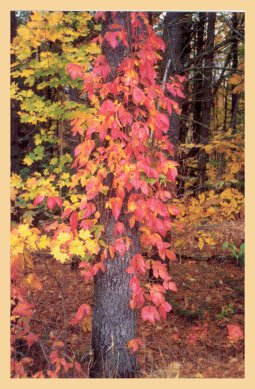 Climber beware! Poison ivy can
be beautiful in the fall, but chemical volatiles from the plant can cause
serious skin problems for many people.
Climber beware! Poison ivy can
be beautiful in the fall, but chemical volatiles from the plant can cause
serious skin problems for many people.
Chemicals are atoms arranged in an
almost infinite number of ways. As the kind of atoms, their arrangements,
and their numbers change, so do their properties. The keywords to
remember when the word chemical is used are atoms, numbers, arrangements
and properties. The kill or cure part of chemicals comes to play when
"amounts" or "dose" are used. The best example of dose is any fast-release
fertilizer. A little promotes lush growth while a lot will kill the
plant. Is the fertilizer good or bad? Is it a helper or a killer?
A professional is a person who understands dose.
We are bags of chemicals, and so are trees. We
and trees grow and mature as chemicals increase and change over time. In
time, chemicals are recycled for new life. Time becomes a major variable.
A major responsibility of arborists is to provide care for trees in ways
that optimize time for high-quality growth.
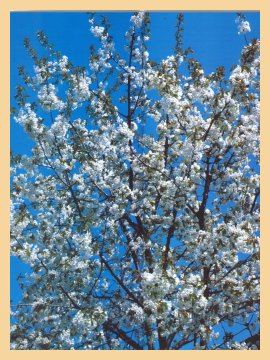 Cherry blossoms are a sign of spring.
When leaves that fall are injured, chemical reactions take place that form
cyanide-based poisons. If animals eat many of the fallen injured leaves,
death could follow.
Cherry blossoms are a sign of spring.
When leaves that fall are injured, chemical reactions take place that form
cyanide-based poisons. If animals eat many of the fallen injured leaves,
death could follow.
Trees and aspirin
Trees through the ages have been the source for chemicals
used by humans for killing and curing. Some tree species stand out
in history. The most commonly used chemical or medicine today originally
came from the bark of the white willow, Salix alba. The medicine, of course,
is aspirin. It is not only a human painkiller - analgesic - but it is often
recommended for lowering the risk of heart attack. The bark
was used by early humans for pain reduction, but it was not until 1899 that
the chemical was discovered. Acetylsalicylic acid is aspirin but salicylic
acid, the base molecule, is in a large family of analgesics. Exactly
how aspirin works is still not well understood. It is known that the
chemical blocks an enzyme that is necessary for nerve impulses.
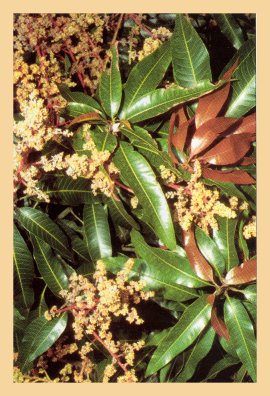 Mango is in the same family as poison ivy.
Some people are affected by chemicals in the skin of the fruits.
Mango is in the same family as poison ivy.
Some people are affected by chemicals in the skin of the fruits.
Trees and malaria
Trees come to the aid of humans again
with the bark of a tree native to South America. Ancient scholars
believed that the cure for any human disease could be found in the plants
growing where the disease was most severe. So it is with quinine, an
alkaloid from the bark of the cinchona tree that grows where malaria is a
severe disease.
The mode of action of quinine is fascinating.
The chemical binds with the DNA in infected cells. More interesting
is that the greater the infection, the greater the binding. Once DNA
is disrupted the cell cannot divide. Maybe the ancients knew more than
we give them credit for.
Quinine is well known also for its place in tonic to
make a gin and tonic. In higher doses, quinine causes uterine
contractions in animals, and this action could lead to abortion. Dose
is the thing!
An alkaloid is a naturally occurring molecule that contains nitrogen.
They are bases (alkaline) and many are poisonous as doses increase.
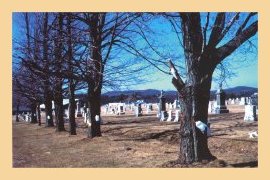 Recycling? Maple syrup cures the "sweet tooth." Maple syrup
is an ingredient in many spring tonics. Sassafras tea sweetened with
maple syrup can be a cure for many ailments.
Recycling? Maple syrup cures the "sweet tooth." Maple syrup
is an ingredient in many spring tonics. Sassafras tea sweetened with
maple syrup can be a cure for many ailments.
Trees and cancer
Taxol is a tree chemical that has
become very well known for its ability to stall some human cancers.
The chemical comes from the bark of the Yew, or Taxus, tree that grows in
the forests along the Pacific Northwest and into Canada.
The mode of action is similar to quinine and many chemicals
used to stall or cure cancers. The chemical taxol attacks the apparatus
that is supposed to stretch as cells divide. Taxol prevents the stretching
and thus inhibits cell division. Remember, humans are regenerating
systems. Parts grow, break down, and are replaced in the same spatial
position. Cancer cells don't like to break down. They only want
to divide. So any chemical that prevents cell division gives the cancer
cells some problems. Taxol does give cancer cells some problems for
rapid division.
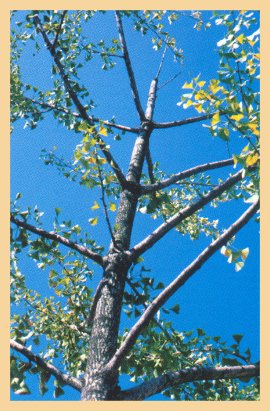 Ginkgo biloba has become a favorite for many people who believe in the
medicinal powers of plant chemicals. The extract is supposed to benefit
memory. Here is a ginkgo tree in its native land of Korea.
Ginkgo biloba has become a favorite for many people who believe in the
medicinal powers of plant chemicals. The extract is supposed to benefit
memory. Here is a ginkgo tree in its native land of Korea.
Trees and other medicines
Aspirin, quinine, taxol - some big
chemical actors - and all from trees originally. When the benefits
of trees to humans are listed, the medicines are often left out. Most
people are not aware that a tree in India, the Neem tree, has been at the
center of international legal disputes. Why? Because the local
people have used the chemical powers of the tree for medicines for centuries.
Now some companies want to concentrate the chemicals and trademark them
for sale. This situation is not unique to India. Many tropical
trees are being tested for the powers of their chemicals. And, again,
local governments are stepping in to regulate or stop possible exploitation.
Most chemicals found in trees are in a very dilute form.
Usually the chemical must be increased in concentration before it can be
used for some purpose. The ancients cooked or boiled the tree parts;
usually the bark. Most of the chemicals
function as enzyme blockers.
This is how most medicines work. To explain this in an extremely crude
way, the chemicals "fit" into places where their presence blocks the next
"fit" of a pathway.
Enzymes: Biohelpers
Enzymes are chemicals that "help"
natural essential processes to go on at highly efficient rates, while the
enzyme itself is not "used up" in the process. Enzymes keep heat down
while reactions speed up. If enzymes did not do their work, the processes
themselves would "burn out" the cells.
Enzymes are big molecules with a protein core.
Proteins are connected amino acids. Most enzymes have two other parts:
one is a vitamin and the other is usually some element. Enzymes are
often likened to keys. For a key to work, it must not only go into the
slot, but the notches at the end must be arranged so that they fit exactly
in the correct position to turn on a device or motor. If a key notch
is altered, the key might slide into the slot, but it will not turn.
Any chemical that connects onto an enzyme might so alter its shape that the
function of the enzyme is blocked. Many enzymes are specific to different
plant and animal species.
The way many pesticides and herbicides kill is that
some introduced chemical alters some unique enzyme that fails to work, thus
causing death.
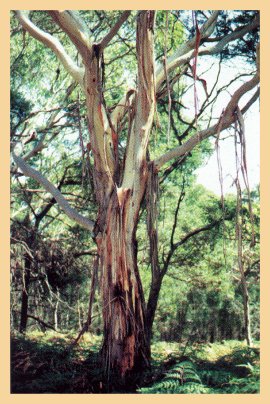 Eucalyptus species have chemicals in their leaves that are used in many
medicines, especially cough drops. The leaves on this eucalyptus species is
the favorite of koalas in Australia.
Eucalyptus species have chemicals in their leaves that are used in many
medicines, especially cough drops. The leaves on this eucalyptus species is
the favorite of koalas in Australia.
Tree defense chemicals
Trees produce chemicals that can
kill other plants, insects and even animals, including humans. Chemicals
that leach from tree parts that kill other plants are called allelopathic
substances. Juglone from black walnut roots is one well known
example. The list of allelopathic substances is long. As I will
discuss later, most of these killer chemicals have a similar base or core
structure that includes a phenol or terpene. But, before I go on with
that, I would like to mention some other common killer chemicals against
insects and animals.
About 25 years ago, the talk was all about trees sending
signals to produce chemicals to kill attacking insects. The experiments
worked well in the laboratory, as so many do, but they did not work outside,
also, as so many do not. The story was that once a few insects began
to attack one tree, that tree would "send out" chemicals that would alert
nearby trees to start producing more chemicals that would stop the attack.
In theory, and in the lab as stated, it all fit. In the field, no
proof. Again, the killer chemicals were phenol based, which can kill
insects.
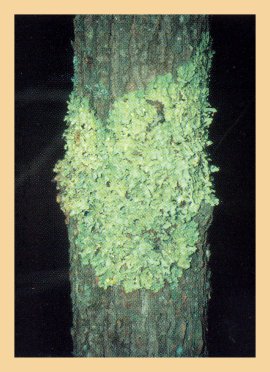 Lichens are tree associates. Their growth indicates clean air.
Many species of lichens will not grow in polluted air.
Lichens are tree associates. Their growth indicates clean air.
Many species of lichens will not grow in polluted air.
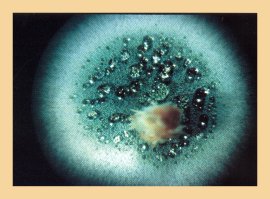 Penicillium species are common inhabitants of fresh tree wounds.
Penicillium species and other non-decay-causing fungi, I think, are nature's
real "wound dressings." Penicillium species produce antibiotics that
have saved many lives.
Penicillium species are common inhabitants of fresh tree wounds.
Penicillium species and other non-decay-causing fungi, I think, are nature's
real "wound dressings." Penicillium species produce antibiotics that
have saved many lives.
Trees and human toxin
Now, onto some "big ones" that can
cause human problems, even death: Just as I gave some good news for aspirin,
quinine, and taxol, the bad news keeps coming back to phenol-based chemicals.
Many trees and other plants produce chemicals that irritate or sicken humans,
but one tree native to south Florida and the tropics can do you in.
It has the ominous common name of poison wood, which tells you something.
The tree is Metopium toxiferum. All parts except the pollen of this
tree are deadly. The tree belongs to an infamous family that causes
many animals and humans problems - Anacardiaceae. Other notable trees
and vines in this family are poison ivy, poison oak and poison sumac.
Mango belongs in this family and some people are highly sensitive to the
skin of the fruit.
Another large family that has some notable species is
the Roseaceae. The major genus that produces harmful chemicals is
Prunus. And the species are Prunus serotina, black cherry, peach P.
persica, and apricot, P. armeniaca. Cyanide is the basic culprit.
In peach and apricot pits it is in a molecule called amydaline. It
has the taste of bitter almonds. The pits of cherries are much smaller,
but they also have similar molecules. In black cherry, cyanide-based
chemicals are also in the leaves, and especially in injured leaves.
Death of cattle is well known after chewing leaves, again especially fallen
injured leaves, have been eaten. A note here is that healthy cherry
leaves contain the nontoxic cyanide precursor prunasin. When the leaves
are injured, the prunasin is split to release prussic acid or hydrocyanic
acid. Cyanide blocks oxygen from bonding with hydrogen, thus blocking
the release of the hydrogen in water. In cyanide poisoning, one could
still breathe even though death is due to suffocation.
Pathway blockers
Blocking enzymes and pathways - and
nasty phenols and terpenes - seem to repeat as the cause of problems.
Some discussion on enzymes has been given. Here is a little more on
the other subjects.
Cells are highly compartmented bodies. Or, you
could say that many smaller bodies are highly compartmented in cells.
The cell bodies are compartmented, yet they pass along their products to
other bodies in the cells. Each body in a cell has a "job" to do.
The job is to process chemicals in a highly ordered and efficient way, as
in an assembly line. These processes are called biochemical pathways.
The pathways differ from the conventional straightforward assembly line in
that there are loops along the way. The loops are places where energy
must come in to power the pathway along. The rules for the pathways
are similar to your computer rules. Unless every dot, dash or comma
is in absolutely the correct place, the system won't work. To make an
extremely long story short, some of the nasty chemicals disrupt or block the
pathways. It really does not matter where in the sequence of items the
block comes; in a short time the entire pathway scrambles or shuts down.
As more pathways shut down, it is not long before chain reactions go on as
others shut down. In the end, the entire system shuts down. We
call it death.
That is the worst-case scenario. There are ways
out of this. Most pathways come with possibilities for shunts - detours.
If you can get to the blocked area soon enough and encourage a shunt, the
pathway could continue. Medicines do this by blocking the blockers.
The shunts work as a temporary fix while the blocker is being unblocked.
(Not very scientific, but that's the way it is.)
Trees, energy and life
Life is a state where a system run
by the power of the sun is so highly ordered that it repeats. We have
seen that the system has many safeguards, redundancies, and protection and
defense schemes. That is the good news. Disrupting agents (non-living)
or pathogens (living) have ways of causing disorder in the system. That
is the bad news.
Trees produce chemicals that defend and protect their
system. The major killer chemicals are phenol- or terpene- based.
The major targets for these killer chemicals are the pathogens that attack
trees: insects, animals, bacteria and fungi. Sometimes humans get into
the animal zone as shown here. But most of the time it is the others
that are the targets.
An extremely quick summary must start with photosynthesis,
where the energy of the sun is trapped in a molecule of ATP, adenosine triphosphate.
Water and carbon dioxide are the main chemicals. Through many elaborate
chemical processes, glucose is formed. In the process, oxygen is given
off. In living cells, the process of respiration releases the energy
stored in glucose and releases the carbon dioxide and water. Oxygen
is required for this process. So, we start with carbon dioxide, water and
oxygen, and we end with the same actors ready to act again as they trap, store,
transport and use the energy of the sun. The end product we call life.
Enough!
Glucose is the key
Glucose is the key molecule here.
It is used to power living processes, but it is also used in other ways.
It could be used to form cellulose, hemicellulose and lignins. Or it
could be altered to a nonsoluble state for future use - starch or oils.
Or, it could be used to form a long list of chemicals essential for life as
defense or protection chemicals. Here I focus on defense chemicals -
phenols, terpenes.
Phenols are found mostly in angiosperms and terpenes
mostly in conifers. Phenols have the basic pattern of a six-carbon
ring with an oxygen and hydrogen on the second carbon. There seems
to be an almost endless number of ways to connect the rings. As the
rings connect, they are called polyphenols. Their major actions seem
to be blocking enzymes, especially in the fungi that cause wood decay.
As always in nature, there are exceptions. Some of the first fungi
that are able to invade tree wounds are those that are able to not only grow
in the presence of polyphenols, but can actually break down the chemicals
and use them as an energy source. The major group are Phialophora species
and related fungi. Many are closely associated with bacteria.
I believe this is an extremely important subject that is not being studied.
I suppose that splitting wood and isolating microorganisms is just not "hot"
now. Too much work.
Terpenes are connections of isoprenes. Isoprene
is the basic building block for many resinous chemicals and even latex and
rubber.
Carbon and the chemistry of life
Organic chemistry is the chemistry
of carbon. Exceptions are diamonds, graphite, coal, oil and a few other
substances that are not considered organic. When you hear "organic,"
you know there is a carbon there someplace. Phenols and terpenes are
organic molecules. They have carbon frameworks. When you connect carbon,
hydrogen and oxygen, you can get thousands and thousands of chemicals for
life. And when you add nitrogen, phosphorus and sulfur, you have molecules
that make up about 98 percent by weight of all living matter.
Tree associates and more chemicals
Trees not only produce chemicals that
kill or cure, they also support, through intimate associations, other organisms
that also produce chemicals that kill or cure. Fungi that produce fruit
bodies we call mushrooms head the list. Many mushrooms are edible, and
others are not. Ancients used mushrooms in many of their ceremonies.
Many of those mushrooms were the fruit bodies associated with mycorrhizae.
The real killers are those in the genus Amanita.
Here is a fungus fact that relates directly to arboriculture
but few people are aware of: One of the most well-known and famous fungi in
the world grows on fresh tree wounds. This fungus produces a chemical
so powerful that millions of people have been cured of many diseases that
could have killed them. The fungus is Penicillium notatum. I isolated
this fungus frequently from the surface of fresh wounds. When this
fungus is around, few others will be. To this day I believe that species
of Penicillium, Mucor, Aspergillus, Alternaria, and a long list of yeasts
and bacteria, are a tree's first line of defense after wounding. In
a sense, these wound surface organisms are nature's real "wound dressing."
It is the only wound dressing that I know of that works. The problem
is that it comes free. It is so sad when you consider how much time
and money has been spent and money made disrupting a beneficial natural defense.
But, you have heard it before. Some are still not listening!
Time to accept chemistry in arboriculture
It is time to accept chemistry in
arboriculture. Arborists that touch trees every day need to know about
tree chemicals. Every species has something, from the fragrance of
a pine to the sweet smell of a birch. Every time you cut into a tree,
you release some chemicals. These chemicals tell you much about the
tree.
In the end, the more you learn about the way trees work, the better and
faster you will be able to work on them.
“An author,
lecturer and consultant, Dr. Shigo started
Shigo and Trees, Associates
twenty
years ago after retirement from the U.S. Forest Service.”
Reproduced with permission of Tree Care Industry
and Dr. Alex L. Shigo.
The article was published in Volume XII, Number 6-June
2001 of TCI.
This site is dedicated to the remembrance of Robert
Felix who for many years worked very hard for the improvement of the tree care industry: 1934-1996.
Back to Articles.
Dictionary MAIN
PAGE
Text & Graphics Copyright © 2009
Keslick & Son Modern Arboriculture
Please report web site problems, comments and words of interest,
not found.
Contact
 Climber beware! Poison ivy can
be beautiful in the fall, but chemical volatiles from the plant can cause
serious skin problems for many people.
Climber beware! Poison ivy can
be beautiful in the fall, but chemical volatiles from the plant can cause
serious skin problems for many people.  Cherry blossoms are a sign of spring.
When leaves that fall are injured, chemical reactions take place that form
cyanide-based poisons. If animals eat many of the fallen injured leaves,
death could follow.
Cherry blossoms are a sign of spring.
When leaves that fall are injured, chemical reactions take place that form
cyanide-based poisons. If animals eat many of the fallen injured leaves,
death could follow.
 Mango is in the same family as poison ivy.
Some people are affected by chemicals in the skin of the fruits.
Mango is in the same family as poison ivy.
Some people are affected by chemicals in the skin of the fruits.  Recycling? Maple syrup cures the "sweet tooth." Maple syrup
is an ingredient in many spring tonics. Sassafras tea sweetened with
maple syrup can be a cure for many ailments.
Recycling? Maple syrup cures the "sweet tooth." Maple syrup
is an ingredient in many spring tonics. Sassafras tea sweetened with
maple syrup can be a cure for many ailments. Ginkgo biloba has become a favorite for many people who believe in the
medicinal powers of plant chemicals. The extract is supposed to benefit
memory. Here is a ginkgo tree in its native land of Korea.
Ginkgo biloba has become a favorite for many people who believe in the
medicinal powers of plant chemicals. The extract is supposed to benefit
memory. Here is a ginkgo tree in its native land of Korea. Eucalyptus species have chemicals in their leaves that are used in many
medicines, especially cough drops. The leaves on this eucalyptus species is
the favorite of koalas in Australia.
Eucalyptus species have chemicals in their leaves that are used in many
medicines, especially cough drops. The leaves on this eucalyptus species is
the favorite of koalas in Australia.  Lichens are tree associates. Their growth indicates clean air.
Many species of lichens will not grow in polluted air.
Lichens are tree associates. Their growth indicates clean air.
Many species of lichens will not grow in polluted air. Penicillium species are common inhabitants of fresh tree wounds.
Penicillium species and other non-decay-causing fungi, I think, are nature's
real "wound dressings." Penicillium species produce antibiotics that
have saved many lives.
Penicillium species are common inhabitants of fresh tree wounds.
Penicillium species and other non-decay-causing fungi, I think, are nature's
real "wound dressings." Penicillium species produce antibiotics that
have saved many lives.